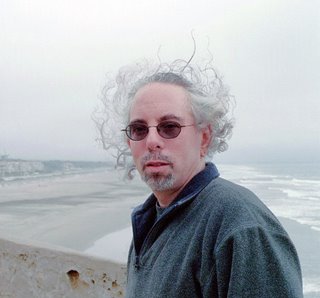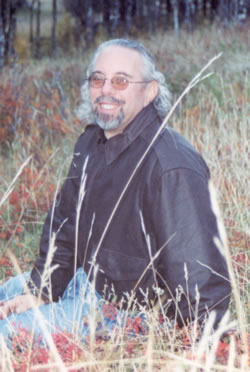Robert King Interviews M. D. Friedman About His Digital Poetry
by Robert King
1) You’re a photographer, musician, and digital artist as well as a poet. You do these things separately, of course, but you also blend them. For example, your digital poem, “Forever Trespass,” is constructed from reading a two-directional poem (one voice reading down the columns, another across the rows) and blending those sounds with animated photographs and digital art.
You’ve written about Dadaism and have said that “Dada poets opted for effect over articulation, for creating an experience over making sense.” Is this what you’re after, an “experience” that’s substantially different than a poem with, let’s say, added effects?
The ability of a digital poem to create a transformational experience, to take the viewer to that place where poetry comes from, a place of intense internal understanding, is greatly enhanced by appealing to the mind in multiple ways rather than with just text. The sound art behind the audio spoken word helps to disengage the logical side of the brain and allow the viewer's emotive mind to respond to the poetic experience in a different way. The first time I heard a recording of Gertrude Stein reading her own work, I found that her barrage of vocal repetition confounded my efforts to understand what she was saying in any sort of literal context. Although this frustrated me at first, I soon surrendered to the rainfall of her words and found their tickling pin prick exhilarating. That is what I am after with much of what I create. I often want to create sensations that the logical use of words are inadequate to describe. I have recently discovered that there is a very significant synergistic effect when I can blend all of my creative pursuits into a single work toward the purpose of drawing the reader/viewer/listener into feeling the feelings I am trying to express. I want to recreate certain feelings I am feeling inside in someone else, to awaken their subconscious to the images we all dream together. I am trying to communicate as directly as I would be if I were there physically touching them.
2) Side-not maybe: Regarding Dada—I got the impression in my youth that the Dadaists wanted to ‘end’ art by taking things to extremes. Is this the wrong impression?
Dada was anti art establishment and anti art hierarchy. They were against the forces they saw destroying the world. I believe they saw themselves as true artists, free to express themselves without the societal constraints of commercially produced art.
3) Regarding your piece The Word,” you’ve described its origin this way: “The images along with artwork and photos flooded my mind while I was in the shower. I went downstairs and started free-styling the audio. The sounds then shaped the animation. Suddenly I arrived somewhere I had never been—somewhere in the middle of groans, flashing color & splintered text.” Most of us writers have experienced the flash of an idea in words, and I can imagine a visual artist getting such a sudden inspiration, but it sounds like you got it almost all at once. Is this unusual for you or do you often start with one specific thing (a word or image or photography or sound) and then layer other media with it?
This was indeed an unusual experience for me. It happened to me previously with my text based poetry only a couple of times, only after a long dry spell, like a thunder shower after a drought. In the case I was referring to, it was with the first digital poem I had ever tried to create, although the idea of doing something in an electronic medium combining my poetry, art, photography, animation and sound art had been nagging at me for several years.
4) What are the strengths and weaknesses of the digital genre? What can you do in a visual mode than you can’t do with print? Could such combinations be distracting to the ‘reader’ or does it enhance the poem?
I think I have already spoken about many of the artistic advantages of this new genre. Another advantage is that it appeals strongly to many people who might not be interested in printed poetry. It seems to engaging especially to the highly stimulated younger generation. Also it is positioned to make excellent use of the rapidly growing market of digitally distributed media for hand held video devices like I-Phones. It's most important weakness for me is that I have yet to figure out how to perform the work live. Another problem is the amount of time it takes to produce a 2 minute piece.
5) To take just one example from your work, and that of several others, a word or phrase is often repeated in a piece. This could be bothersome (or some other negative adjective) in print but it doesn’t seem to be in an aural mode. Can one work with language in a recognizable way (i. e. syntactically) and still develop an enhanced effect?
Yes. Yes. Yes. Yes Yes. Yes Yes. Yes Yes. Yes Yes Yes Yes. Yes Yes. Yes Yes Yes Yes Yes Yes Yes Yes. Yes. I have seen poetry videos (that look like old MTV style music videos) do that well. I also find that song writers often get away with poetry that would not stand well alone on the printed page because they over rely on the power of the music to enhance their words. Personally, I find if what I want to communicate I am able to describe or argue well with syntactic language, then the simple written word is a most effective means.
6) How can/do you “publish” or perform visual poetry? Again, how is this different from traditional ‘written-only’ poetry?
Since my digital poetry is delivered in a video format, I can publish it on DVD or as a downloadable video file. I am actually using the same "print on demand" service to do this that I have already used to published a couple of my print manuscripts (www.lulu.com). Although my digital poetry could be projected on a big screen with surround sound at your local movie theatre, I have no idea how to perform it live. Wouldn't it be cool if digital poetry took over the role cartoons used to play at movie theatres!
7) What’s next? What are the trends in the new genre? Is there any direction in the experimentation?
When I find the time to make another digital poem, I want to play some more with the "voicing" of the lines. By this, I mean I want experiment to with ways that create the effect of the reader/viewer/listener hearing some of the words in their head as if they were spoken in their own voice.
Labels: dada, digital, electronic, Friedman, Interview, King, M. D. Robert, new, poetry, video, visual


